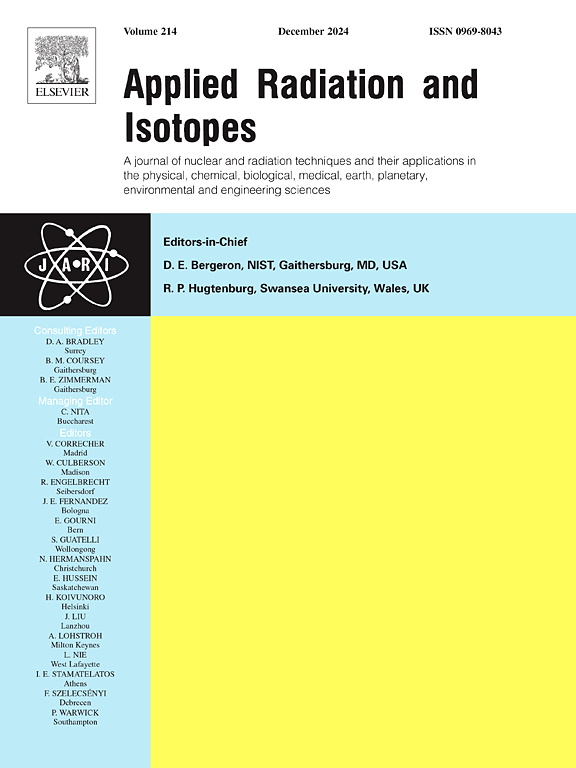巴拉那联邦技术大学土木工程课程实验室氡浓度的测量和建筑材料对剂量限值的影响
IF 1.6
3区 工程技术
Q3 CHEMISTRY, INORGANIC & NUCLEAR
引用次数: 0
摘要
氡是一种放射性致癌气体,几乎存在于整个地壳中,容易在室内积聚。氡的剂量取决于其室内浓度和暴露时间。建筑材料含有来自地壳的元素,也含有自然产生的放射性物质,通常是少量的。然而,岩浆来源的物质,如花岗岩,往往是重要的潜在氡来源。为了评估处理建筑材料的环境的安全性,重要的是评估与材料和环境中的电离辐射(如氡)有关的物理风险。在这项研究中,测量了室内环境和土木工程实验室(编码为1、2、11、12和16)中使用的建筑材料中的氡浓度。这些实验室位于库里蒂巴的帕拉纳联邦科技大学本文章由计算机程序翻译,如有差异,请以英文原文为准。
Measurement of radon concentration in laboratories of the civil engineering course of Federal Technological University of Parana and the contribution of construction materials to dose limits
Radon is a radioactive, carcinogenic gas present in nearly the entire Earth's crust, which tends to accumulate indoors. The dose of radon received depends on both its indoor concentration and the duration of exposure. Building materials, which contain elements from the Earth's crust, also contain naturally occurring radioactive materials, typically in small amounts. However, materials of magmatic origin, such as granite, tend to be significant potential sources of radon. To assess the safety of environments where construction materials are handled, it is important to evaluate the physical risks associated with ionizing radiation (such as radon), both in the materials and in the environment. In this study, radon concentrations were measured in indoor environments and construction materials used in civil engineering laboratories (coded as 1, 2, 11, 12, and 16) at the Federal Technological University of Paraná, Ecoville Campus in Curitiba. For this, 50 passive diffusion chambers equipped with CR-39 detectors were placed in 5 laboratories, with 10 detectors per laboratory. Additionally, construction materials frequently used in these laboratories were analyzed using an active detector, AlphaGuard, which measures alpha activity concentrations through an ionization chamber. The results indicated that the construction materials handled in the laboratories have little impact on the indoor radon concentration. The majority of the radon activity concentrations were mainly influenced by the soil beneath the laboratory. Of the diffusion chambers, 14 % showed concentrations between 200 and 400 Bq/m3, a level of concern, and 2 % of the chambers showed concentrations above 400 Bq/m3, indicating the need for monitoring and mitigation actions. However, given that the limits established are conservative and considering the exposure time of users, it was concluded that the indoor environments analyzed do not pose a physical risk from ionizing radiation.
求助全文
通过发布文献求助,成功后即可免费获取论文全文。
去求助
来源期刊

Applied Radiation and Isotopes
工程技术-核科学技术
CiteScore
3.00
自引率
12.50%
发文量
406
审稿时长
13.5 months
期刊介绍:
Applied Radiation and Isotopes provides a high quality medium for the publication of substantial, original and scientific and technological papers on the development and peaceful application of nuclear, radiation and radionuclide techniques in chemistry, physics, biochemistry, biology, medicine, security, engineering and in the earth, planetary and environmental sciences, all including dosimetry. Nuclear techniques are defined in the broadest sense and both experimental and theoretical papers are welcome. They include the development and use of α- and β-particles, X-rays and γ-rays, neutrons and other nuclear particles and radiations from all sources, including radionuclides, synchrotron sources, cyclotrons and reactors and from the natural environment.
The journal aims to publish papers with significance to an international audience, containing substantial novelty and scientific impact. The Editors reserve the rights to reject, with or without external review, papers that do not meet these criteria.
Papers dealing with radiation processing, i.e., where radiation is used to bring about a biological, chemical or physical change in a material, should be directed to our sister journal Radiation Physics and Chemistry.
 求助内容:
求助内容: 应助结果提醒方式:
应助结果提醒方式:


